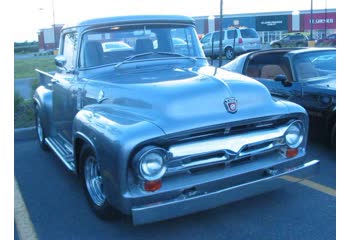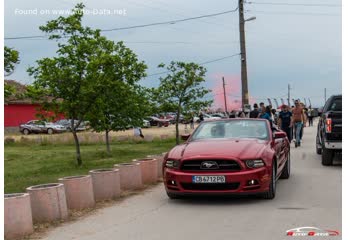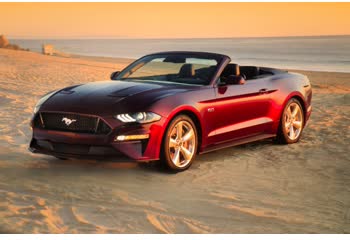Everything you need to know about specifications and performance - Ford F-Series F-100/F-150 2023 - 5.0 V8 (400 Hp) SelectShift

Overview:
What is the engine capacity of a Ford F-Series F-100/F-150 2023?
The engine capacity of the Ford F-Series F-100/F-150 2023 is 5038 cm.
Ford F-Series F-100/F-150 2023 How many horsepower?
The engine power of the Ford F-Series F-100/F-150 2023 is Internal Combustion engine.
What is the Ford F-Series F-100/F-150 2023 engine?
Ford F-Series F-100/F-150 2023 engine is Coyote. (Click to see other cars using the same engine)
How much gasoline does a Ford F-Series F-100/F-150 2023 consume?
The Ford F-Series F-100/F-150 2023 consumes 12.4 liters of gasoline per 100 km
General:
Brand: Ford
Model: F-Series F-100/F-150
Generation: F-Series F-150 XIV SuperCrew (facelift 2023)
Modification (Engine): 5.0 V8 (400 Hp) SelectShift
Start of production: September, 2023
End of production:
Powertrain Architecture: Internal Combustion Engine
Body type: Pickup
Seats: 5-6
Doors: 4
Engine:
Engine systems: Start & Stop System
Power: Internal Combustion Engine
Power per litre: 79.4 hp/l
Torque: 556 nm @ 4250 rpm.
Engine Model/Code: Coyote
Engine displacement: 5038 cm
Number of cylinders: 8
Engine configuration: V-engine
Number of valves per cylinder: 4
Fuel injection system: Direct injection and Multi-port manifold injection
Engine aspiration: Naturally aspirated Engine
Valvetrain: DOHC, Ti-VCT
Engine oil capacity: 7.33 l
Coolant: 12.5 l
Engine layout: Front, Longitudinal
Cylinder Bore: 93 mm
Piston Stroke: 92.7 mm
Compression ratio: 12:1
Performance:
Fuel Type: Petrol (Gasoline)
Fuel consumption (economy) - urban: 14.7 l/100 km
Fuel consumption (economy) - extra urban: 9.8 l/100 km
Fuel consumption (economy) - urban (EPA): 14.7 l/100 km
Fuel consumption (economy) - extra urban (EPA): 9.8 l/100 km
Fuel consumption (economy) - combined (EPA): 12.4 l/100 km
Fuel consumption (economy) - combined: 12.4 l/100 km
Weight-to-power ratio: 5.4 kg/Hp, 184.9 Hp/tonne
Weight-to-torque ratio: 3.9 kg/Nm, 257.1 Nm/tonne
Space:
Kerb Weight: 2163 kg
Max. weight: 3107-3221 kg
Max load: 944-1058 kg
Trunk (boot) space - minimum: 1495 l
Permitted trailer load with brakes (12%): 5761 kg
Fuel tank capacity: 136 l
dimensions:
Ramp-over (brakeover) angle: 17.1°
Length: 5893 mm
Width: 2029 mm
Height: 1915 mm
wheelbase: 3693 mm
Width with mirrors folded: 2123 mm
Width including mirrors: 2431 mm
Front track: 1725 mm
Rear (Back) track: 1735 mm
Front overhang: 950 mm
Rear overhang: 1250 mm
Ride height (ground clearance): 208 mm
Minimum turning circle (turning diameter): 14.6 m
Approach angle: 21°
Departure angle: 18.6°
Powertrain, Suspension and Brakes:
Drivetrain Architecture: The Internal combustion Engine (ICE) drives the rear wheels of the vehicle.
Drive wheel: Rear wheel drive
Number of gears and type of gearbox: 10 gears, automatic transmission SelectShift
Front brakes: Ventilated discs, 350x34 mm
Rear brakes: Ventilated discs, 336x20 mm
Assisting systems: ABS (Anti-lock braking system)
Steering type: Steering rack and pinion
Power steering: Electric Steering
Tires size: 245/70 R17; 265/70 R17; 265/60 R18; 265/70 R18; 275/65 R18; 275/60 R20; 275/50 R22
Wheel rims size: 17; 18; 20; 22
Front suspension: Double wishbone, Independent coil Spring
Rear suspension: Rigid axle suspension, Leaf Spring
See also

Other generation.
Its production began in 1955 until 1955

Same engine. (Coyote).
Its production began in 2012 until 2014

Same engine. (Coyote).
Its production began in 2017 until 2021
Write a comment